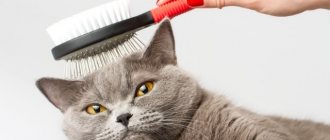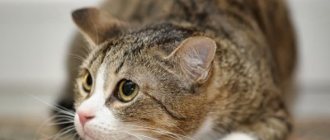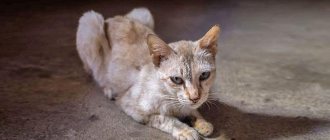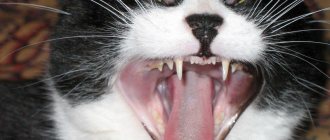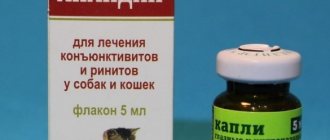In veterinary practice, the human drug “Floxal” for cats is used in cases where it is necessary to treat ophthalmological diseases in a pet. This medicine has a strong antibacterial effect, which applies to Gram (-) and Gram (+) microorganisms. “Floxal” is sold in the form of drops for instillation into the eye cavity and, despite the fact that it is intended to treat people, it can also be used to treat cats. However, animals can only use Floxal in their eyes if prescribed by a veterinarian.
Composition and properties
The drug "Floxal" consists of the active component - ofloxacin and such auxiliary substances that perform a secondary function, such as purified water, hydrochloric acid and sodium chloride. Most often, Floxal drops are used to treat eye diseases in cats, but this is not the only form of the medicine; the manufacturer also offers the medicine in the form of an ointment. It includes white petroleum jelly, wax and lanolin as additional ingredients.
The antibiotic is effective against gram-positive and gram-negative bacteria, and its effect is to inhibit the DNA of the microbial cell, which leads to the death of the entire pathogenic microorganism.
Indications for use
Indications for starting the use of the medication are infectious eye diseases that are caused by microorganisms sensitive to ofloxacin. Such diseases include :
- conjunctivitis;
- corneal ulcer;
- keratitis;
- mycoplasmosis;
- blepharitis.
Also, Floxal drops for cats can be used as a preventive measure after traumatic eye injuries or surgery, therapy for inflammation caused by infection after eye surgery.
© shutterstock
When is it appointed?
According to the instructions for use, it is advisable to use Floxal eye drops for kittens and older individuals who have been diagnosed with the following ophthalmological pathologies:
Drops can be prescribed to a furry cat who suffers from a corneal ulcer.
- an inflammatory process in the mucous membrane of the eye caused by an allergic reaction or infection;
- ulcerative lesion of the cornea;
- inflammation of the transparent anterior surface of the organ of vision;
- mycoplasmosis;
- inflammation of the edges of the eyelid.
In addition, veterinarians can prescribe Floxal to a cat as a preventive measure for complications in the visual system after injuries. For preventive purposes, antibacterial drops are also prescribed to cats who have undergone surgery, as well as to treat inflammation caused by infections after ophthalmological operations.
the kitten's eyes are festering
At the very beginning, when the disease first appeared, it is practically not dangerous for the cubs. But if conjunctivitis is not treated, it can cause serious harm to the kitten’s health. The kitten's eyes are rotting! what to do?In newborn babies it is common
purulent discharge from the eyes is observed.
When a little kitten wants to open his eyes, he simply cannot do it.
The cub requires immediate treatment. You need to wash your kitten's eyes
chamomile decoction. To rinse, you need to wet a small piece of cotton wool with warm broth and carefully rinse off the discharge, and then carefully rinse the inflamed eye itself.
, special eye drops or eye ointments are used for treatment
In pharmacies you can find drugs such as “Iris”, tetracycline ointment, “Diamond Eyes” and so on.
Before use, be sure to read the instructions for use of a particular drug. Problems with eyes in kittens? what to treat? You can use saline to wash your eyes
. solution or drinking water, for discharge from the eyes, use a solution of furatsilin prepared in a pharmacy for the eyes of a kitten, the eyes are stuck together (they are just beginning to open them) and dried crusts can first be wiped with a cotton wool soaked in chlorhexidine to remove the crusts, and then with chloramphenicol drops - them moisten some cotton wool and immediately lightly wipe the eyes, do this for 2-3 days, and then everything will return to normal.
Phytoelite for eyes
also wipe normally or with boiled water.
Eye stuck with pus
- Rinse your eyes well and buy it from the vet. pharmacy drops IRIS with gentamecin (the most gentle of the ABs). Drip every 4 hours for 5 days.
Bought per person pharmacy (increases eye immunity) and Floxal.
I diluted one bottle of Poludan in sterile saline solution in 2 ml and instilled 3 drops into each eye 3 times a day for 4-5 days. Floxal drip 2 drops twice a day. Be careful not to blink away the medicine right away. Phloxal also dripped and at the same time Poludan.
Floxal is an ophthalmic antibiotic, and ophthalmoferon is an antiviral drug.
Usually they are prescribed together - we drop one, and 15 minutes later - another.
But this is with serious discharge from the eyes. Ophthalmoferon is very stinging. How to put drops into eyes correctly?
It is important to hold the kitten firmly in your arms, but not to squeeze its body. Eyelids that are stuck together due to illness must first be soaked with a water infusion or decoction of chamomile or black tea. After this, you need to remove the pus, and then apply drops to the sore eye. You need to open your eyelids a little, then apply the medicine so that it gets into the eye, washes it well, and then rolls down to the baby’s nose.
Treatment usually lasts about a week.
How to drip correctly?
The success of the entire treatment course depends on how correctly the therapy proceeds. Typically, Floxal is used for cats in combination with other medications. Moreover, if the veterinarian prescribed drops and ointment at the same time, then between manipulations you need to maintain a time interval and first instill the solution, and only after a while put the ointment in the eye. The dosage of antibiotics for cats is determined by a veterinarian depending on the diagnosis and the general health of the cat. Usually the medicine is dripped up to 5 times a day for at least 2 weeks. After placing the ointment in the lower eyelid, you need to keep your pet's eyes closed for a while and ensure complete rest. Breeders note that the ointment is absorbed well, does not cause discomfort and does not stick to the eyes.
Is treatment possible at home without veterinary care?
Before you start treating your kitten at home, you need to take him to an appointment with a veterinarian. It is very important to find out the real cause of inflammation. If it is accompanied by a general deterioration in health, sneezing, coughing, and upset bowel movements, the pet may be seriously ill.
Some dangerous diseases, such as calcivirosis or viral rhinotracheitis, often occur with symptoms of damage to the organs of vision. The veterinarian will examine the pet, take tests and make a diagnosis. If a serious infectious disease is detected, eye drops alone cannot be used; complex treatment will be required.
Attention! You can treat a kitten at home only after examination at a veterinary clinic.
How and what to wash a kitten's eyes with
Washing the eyelids is the first thing to do if the inflammatory process begins. You need to carefully remove crusts and discharge with a cotton pad. It is moistened in warm boiled water, saline or strong tea without additives. Each eye is wiped with a clean swab in the direction from the outer corner to the inner. On each side you will need 5-6 cotton pads or gauze pads. Do not dip a dirty swab into the rinsing solution.
Washing a kitten's eyes
A strong infusion of chamomile can also be used to cleanse crusts and pus from the eyelids. This remedy helps relieve inflammation. For brewing, it is better to take the flowers of the plant in bags. For 1 cup of boiling water you will need 4 bags of chamomile. Before using the infusion, it is important to make sure that it is not hot. The washing procedure is done 4–5 times a day.
How to put eye drops on your pet correctly
Dealing with a sick pet, even if it is small, is not so easy. The animal will resist treatment procedures. You may need an assistant to secure your four-legged friend. The cat is placed on its back and its paws are held down. A second person carefully removes the pus from the eyelids. Only after this can you use the drops.
The lower eyelid is pulled back slightly with the thumb, fixing the cat’s head so that it does not twitch. The bottle is kept at a distance of 1 cm from the eyeball, the dropper should not touch the eyelid. Inject the required amount of solution into the formed pocket. Next, do the same with the second eye.
Putting eye drops on a cat
Contraindications and adverse reactions
The drug is strictly contraindicated for a pregnant pet.
According to numerous reviews from animal breeders and the results of scientific research, the antibacterial drug “Floxal” is well tolerated by cats and only in exceptional cases provokes negative effects. In addition, the antibiotic has virtually no restrictions on its use. The only thing is that it is not prescribed to animals with personal intolerance to any component from the Floxal composition and to pregnant animals.
It is extremely rare that during treatment of eye pathologies with Floxal, a cat may develop such undesirable effects as:
- redness of the dermis;
- discomfort in the visual apparatus;
- burning, dryness and itching of the eyes;
- photophobia and increased lacrimation;
- dizziness;
- loss of orientation.
The presence of any negative effect in a pet when treated with the Floxal antibiotic requires discontinuation of the medication and consultation with a veterinarian.
Signs of eye disease in dogs
It is quite difficult to protect your pet from injuries and inflammatory processes resulting from pathogenic microflora entering the mucous membrane of the eye. But regular care, use of special means and monitoring the condition of the visual organs is a feasible task. There are a number of characteristic signs that allow the owner to suspect a dog has an eye disease. It is often impossible to make a diagnosis on your own. But careful observation of the dog’s eyes and identification of alarming signs will allow you to promptly seek qualified help from a veterinary clinic.
Squinting
If your dog develops the habit of squinting one or both eyes, you should immediately take it to the vet. This behavior can be a symptom of a wide range of diseases, such as conjunctivitis or corneal erosion. It is quite difficult to detect corneal erosion at the initial stage of the pathological process. But the habit of squinting your eyes can become exactly that life-saving symptom that will allow you to diagnose the disease in time. Lack of timely treatment can lead to clouding of the cornea, and this is a direct path to partial or complete loss of vision.
The cause of corneal erosion may be:
- an inflammatory process that develops as a result of the ingress of pathogenic microflora;
- allergic conjunctivitis;
- corneal injuries;
- insufficient production of tear secretion, which leads to the development of dry eye syndrome.
If the owner ignores the characteristic squinting of the pet, then corneal erosion can develop into an ulcer within a short period of time. Experiencing pain and discomfort, the dog involuntarily squints the affected eye.
Squinting may be a sign of photophobia not associated with visual pathology. Photophobia can be observed in such dangerous diseases as canine distemper and rabies. Therefore, the owner should not ignore this seemingly insignificant symptom.
Redness or other discoloration of the conjunctiva
The reason for the appearance of a reddish tint in the mucous membrane of the dog’s eyes can be:
- allergic reaction. It can develop on food, dust, pollen of certain types of plants, medications, hair or feathers of pets, chemical reagents used by the owner for cleaning the house;
- pathological processes of the organs of vision (conjunctivitis, keratitis and many others);
- injuries resulting from physical, chemical or thermal exposure.
The owner should pay attention to the dog’s health even if the animal’s conjunctiva is too pale, yellowish or bluish. This is one of the signs of diseases not related to the eyes. Yellowness of the mucous membranes can be a sign of babesiosis, blueness can be a sign of problems with the cardiorespiratory system. The most alarming sign is the “porcelain pallor” of the mucous membranes. This symptom indicates acute blood loss, severe anemia, or other life-threatening conditions. You should consult a doctor immediately!
Discharge of pus
The appearance of purulent discharge is a serious sign of eye disease. The owner needs to observe the dog and not confuse mucus and pus. The first appears when a speck or small foreign body gets into the eye. At the same time, a tear secretion begins to be actively produced, which envelops and naturally removes the speck.
If an injury occurs to the mucous membrane of the eye, tear duct or cornea, and a secondary infection occurs, the eyes begin to fester. In this case, the owner’s delay may cost the dog his sight. The danger of purulent discharge is that it can appear only a few days after the onset of the inflammatory process. And in this case, the disease turns out to be already advanced, which means that the duration of treatment increases.
If purulent discharge appears in a puppy, then we are talking not only about pathology of the organs of vision. Perhaps the baby is developing a serious infectious disease, and it needs to be treated using a combination of drugs.
Cloudiness of transparent membranes
If your animal's eyes become cloudy, this should also be a reason for immediate consultation with a veterinarian. As a rule, such a symptom indicates serious problems, such as corneal erosion or ulcers, vascular keratitis, or the appearance of cholesterol or calcium plaques. Cloudiness can also be caused by glaucoma or degenerative changes. You should not discount possible clouding of the lens.
Signs of injury
Injuries to the visual organs are common in animals with bulging eyes. Such breeds include, for example, Yorkshire terriers, pugs, Pekingese, and bulldogs. But dogs of other breeds can also get eye damage. Characteristic signs of injury include the following:
- There is copious discharge from the eyes. They may be mixed with blood or pus;
- the dog does not allow you to touch the sore eye, and if severely injured, it may try to bite the owner when trying to touch the muzzle;
- squinting appears, indicating the presence of discomfort and pain in the injured eye;
- When the cornea is damaged, whitish spots or stripes appear on it. The surface becomes cloudy and the eye loses transparency.
The owner should pay special attention to another type of injury - concussion injuries. They occur as a result of a strong blow to the animal's head. A feature of this damage is the absence of characteristic signs at the initial stage of the process. Only after a few days or weeks does the owner notice that his pet’s vision has become worse. Concussion trauma can result in corneal detachment, capillary rupture, and intraocular bleeding. All this can cause the development of complete or partial loss of vision.
Veterinarians recommend that at the first sign of disease or eye damage in a dog, immediately consult a specialist. It is possible to preserve an animal’s vision only with timely treatment, as well as qualified work by a doctor and strict compliance by the owner with all the veterinarian’s recommendations.
What analogues are there?
In terms of the active substance, Ofloxacin is a complete analogue of the drug, but is available in tablet form.
If it is not possible to treat the animal with the antibacterial drug Floxal, the veterinarian selects a drug that has a similar effect and is no less safe for the cat’s health. One of these is the drug “Ofloxacin” with the main substance of the same name in its composition. But if Floxal is intended for external use, then its analogue should be taken orally, since it is available in tablet form. Usually, Ofloxacin is prescribed for cats, ½-1 tablet, depending on the pet’s body weight. The duration of the treatment course and the advisability of taking a particular medication is determined exclusively by a veterinarian; self-medication is strictly contraindicated for animal breeders.
Phloxal
Floxal (INN ofloxacin) is an antibacterial drug of the fluoroquinolone series for use in ophthalmic practice. It blocks the enzyme DNA gyrase in bacterial cells, resulting in a bactericidal effect. Active against E. coli, Salmonella, Proteus, Morganella, Shigella, Klebsiella, Enterobacter, Serratia, Citrobacter, Yersinia, Haemophilus influenzae, Neisseria, Mycoplasma, Legionella, Chlamydia, Staphylococcus, Streptococcus. Does not affect anaerobic bacteria. Used to treat bacterial infections of the anterior eye. A distinctive feature of the drug is the possibility of its use in pediatric practice, incl. in infants. Most local antibacterial ophthalmic drugs irritate the conjunctival membrane to one degree or another, which is unacceptable in childhood. Floxal is adapted for use in children and does not cause any discomfort or pain when instilled. According to clinical studies, when using Floxal topically, systemic adverse reactions do not develop, which allows the drug to be used, incl. and in newborns. Single dose - 1 drop into the conjunctiva of the infected eye. Frequency of application 2-4 times a day. It is not recommended to use the drug for more than 14 days. If the treatment strategy involves the use of another local drug, then the minimum time interval between instillations should be at least five minutes.
For eye ointment, a single dose is a strip of ointment one and a half centimeters long. The frequency of use is 2-3 times a day, and if the causative agent of the infection is chlamydia, then 5 times a day. Both dosage forms of the drug can be used within the same medication course. If the ointment is used simultaneously with other drugs, then it should be used last. The drug is not absorbed into the systemic circulation and therefore does not exhibit any systemic side effects. Only local allergic reactions are possible: redness and/or conjunctival membrane, itching and burning sensation, photophobia, lacrimation. Dizziness is extremely rare. Direct contraindications to taking the drug are pregnancy, breastfeeding, individual intolerance to ofloxacin or other fluoroquinolone antibacterial drugs. During a medication course involving the use of Floxal, you must refrain from wearing contact lenses. Considering the risk of developing photophobia, when using Floxal it is recommended to wear sunglasses and avoid prolonged exposure to directed and intense sunlight. Since vision may temporarily deteriorate immediately after instillation of the ointment, during this time you should refrain from driving a car or engaging in other activities that require concentration and attention.

